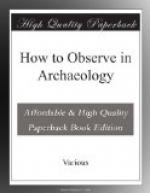(2) 1000-700 B.C. probably: inscriptions generally cut on stone, dark and hard (black basalt), or on the living rock, in hieroglyphic writing. The hieroglyphs are either cut in relief (VI, Fig. 4) or incised (VI, Fig. 2). Found in the same region and sporadically west of the Halys.
(3) From 1400 B.C. and 900 B.C. onwards monuments and sculpture. Human figures are short and thick, generally wearing boots with toes turned up (VI, Fig. 3.) Found in the same regions as the inscriptions and also west of the Halys to the sea.
B. Lydian inscriptions.
From about 500 B.C. Letters mostly like Greek capitals (sometimes reversed); (Illustration IV, at bottom).
C. Lycian inscriptions and monuments.
From about 500 B.C. inscriptions, sometimes with a
Greek translation.
(IV, at bottom.)
Monuments, mostly with inscriptions, are generally tombs in stone, built to imitate wood, with the ends of beams projecting or showing.
D. Greek antiquities.
(1) Early period to 323 B.C. the great Greek colonies on the seaboard and in the coast valleys really formed an outlying part of Greece, and for them the section on Greece should be consulted.
(2) Periods of Seleucid and Pergamene rule, 323-130 B.C. Inscriptions of these periods to be found mostly in the coastal region, rarely on the plateau. Chiefly royal ordinances, thank offerings, municipal honorary inscriptions, decrees, covenants, and the like.
(3) Graeco-Roman period, 130 B.C.-A.D. 400. Language of inscriptions remains normally Greek, though the lettering gradually assumes a different character from century to century, steadily deteriorating. The Phrygian language, written in Greek letters, survives for several centuries in epitaphs, part of the inscription often being in Greek.
Latin inscriptions are not common except in Roman colonies during the earlier centuries of their existence. Elsewhere they are chiefly official documents of various kinds (e.g. imperial ordinances, milestones usually of columnar shape with the Emperor’s titles, boundary stones, &c.), or expressions of homage to Emperors, honorary inscriptions to governors and other officials, dedications, epitaphs, &c. Sometimes a Greek version is added.
Latin inscriptions of the Republican period (recording decrees of the Senate) are extremely rare.
[Illustration VI: Hittite inscriptions, etc.]
CHAPTER IV
CYPRUS
[The traveller will find the Catalogue of the Cyprus Museum, by J. L. Myres and M. Ohnefalsch-Richter (Oxford, 1899) indispensable for the study of Cypriote Antiquities. Reference may also be made to Myres, Catalogue of the Cesnola Collection of Antiquities from Cyprus (New York, 1914). They contain numerous illustrations of types, and make diagrams for the present section unnecessary.]




